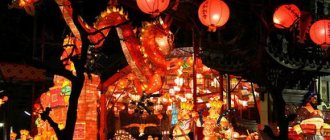What are the origins of nengajo?
The Japanese custom of sending written New Year's greetings dates back to at least the Heian era (794-1185), when nobles began writing such letters to people who lived too far away.
When the Japanese postal service followed Europe's lead and created postcards in 1871, they were ideal for these greetings, which required only the writing of “Happy New Year,” name and address. This tradition has continued since then, becoming one of the most common New Year's customs throughout Japanese history.
Just as many Westerners send Christmas cards to family and friends, the Japanese send nengajō to friends and relatives, colleagues and business partners, clients and sponsors across the country, conveying seasonal greetings and good wishes to everyone.
New Year's card from the times of the USSR.
"Nengadze"
The growth of electronic messaging services has naturally contributed to the ongoing decline in the number of nengajo sent annually. In 2004, approximately 4.45 billion New Year's cards were delivered nationwide. In 2021, Japan's postal service delivered approximately two billion New Year's cards. In other words, an average of 15 pieces per person.
Really busy people can even outsource the entire process to online printing companies and complete everything in a couple of clicks (as long as they have the names and addresses handy).
Eighty-nine percent of respondents said they regularly send New Year's cards, with 69.8% of those people expressing a desire to receive paper cards in the mail. Japan doesn't seem quite ready to make the leap needed to bring the tradition online.
However, some people don't believe the custom is worth the time and effort. On Twitter, many women are complaining about the extra tasks they're saddled with during the holiday season.
Traditions
“I need to do something with Christmas cards,” wrote @perorinsaya. “This is such a nuisance, I’m already sick. All the cards I prepare are for my husband's family and friends. It's his business, not mine, so why should I do it every year? And yet here I am, writing congratulations and making sure they get them to mailboxes on January 1st. I'm such a sweetie."
Japanese postcard (nengajo) 2021 year of the dog. Translation of the text: Congratulations and Happy New Year! Thank you for your great help last year. I hope for your help again. 1st of January
A number of traditions arose around nengajō One is that the nengajō is signed by hand, even if the card is entirely pre-printed. This is an opportunity for the Japanese to show off their calligraphic art.
The other is the nengajō lottery . The Japanese Postal Service issues a number of special nengajo that have lottery numbers on them. On January 15, the winning numbers are selected and then announced on TV and in newspapers. Prizes range from a flat screen TV, free vacation, laptop, various kitchen appliances, special unique food items, video game systems to souvenirs and small items.
Postcards that everyone is waiting for: Japanese New Year cards nengadze
The New Year is approaching, and a very important moment comes for the Japanese - to send New Year's cards to nengajō on time so that the recipient receives them early in the morning on January 1st.
The Japanese attach great importance to this custom. The exchange of New Year's cards is an annual greeting, especially to those relatives, friends and acquaintances who have not been seen for a long time, and a short story about yourself and your family, usually a printed photograph of children, a wedding, an entrance and graduation ceremony, a few lines by hand, traditional Japanese New Year motifs, New Year's lottery number - the draw is held at the end of January and using the number you can win prizes from the Ministry of Mass Communications - from a TV and gift sets of sweets to postage stamps. Postcards are sent not only by individuals, but also by companies and public organizations in order to thank their employees or people who provided them with services in the past year.
The history of nengadze goes deep into antiquity, approximately in the 8th century AD, the Nara era (710-794) when the tradition of making New Year's visits on the first days of the New Year arose, in subsequent years representatives of noble families and aristocracy for the first time began to send written greetings with New Year's greetings to people and officials living far away, whom it was difficult to reach in person. Such letters became traditional for samurai society, and not only samurai, but also ordinary townspeople began to send holiday messages. Messages were delivered both by the official postal service and by private messengers.
In 1871, after the Meiji Restoration, a postal system was created and postcards began to be sent by mail, at first there were not many of them, but after the release of official postcards in 1873, due to their cheapness and ease of sending, this custom quickly spread among the general population.
By 1887, the custom of sending nengajō on New Year's Day had become generally accepted among the Japanese, and the number of postal items during the holidays increased significantly. The post office was not ready for such an overload, there were not enough workers to process and deliver New Year's mail, delivery was late and slowed down the work of the post office, so in 1890 the post office management even tried to limit the number of postcards sent, however, the custom became so popular that the Japanese abandoned it didn't want to. The post office gradually optimized the process and introduced “January 1” stamps, which were used to cancel postcards from December 26 to 28.
In 1899, nengadze became a special type of postal service. Postcards were brought to the post office by senders between December 20 and December 30, they were stamped “January 1” and were delivered to recipients on the morning of January 1. In addition to postcards issued by the post office, it was soon allowed to send postcards made directly by the senders. At first, senders had to collect all their cards in a pile and personally bring them to the post office, and in 1907 they could already put them in the mailbox by writing “New Year's card” on them. There are also special “New Year stamps” for nengadze. Postcards were not officially accepted until 1923 after the Great Tokyo Earthquake, 1926 due to the death of Emperor Taisho, and during World War II.
After the war, cards were again accepted at the post office, and in 1949, the Postal Ministry first issued “New Year's Cards with Lottery Number to Win,” which quickly became popular among the Japanese. New Year postage stamps were also issued.
In the 70s, postcards with drawings and hieroglyphs printed on them gained popularity.
Stamps with numbers for the New Year's lottery also appeared.
This is what nengadze postcards look like on the reverse side. The squares at the top are for the sender's postal code, at the top left are special New Year's stamps, and the numbers at the bottom are for the recipient of the postcard to draw a lottery, in which they can actually win wonderful prizes.
In the 21st century, due to the spread of laser printers and printing, postcards began to be printed on computers and printers, and special postcards for home printing of New Year's cards began to be sold.
What do they write on postcards?
1. Congratulatory part. Happy New Year.
2. Additional text. Thank you for your help last year. We hope for your attention this year.
3. Date. Year. First of January.
Types of postcards.
1. Handmade cards, made with brushes, paints, inks, decorated with your own drawings and calligraphy, with photographs of the family, are also made using handmade stamps.
2. Postcards printed to order in a printing house, ready-made postcards sold at the post office or in stores.
If someone in the family has died, nengadze is not sent this year; instead, special cards are sent saying that the family is in mourning, and this card replaces the holiday greeting.
In Japan, the reception of New Year's cards begins in December, and special mailboxes are organized to receive them, and temporary employees and students are recruited to the post office in the sorting and delivery department in order to deliver New Year's messages to the recipients on time and on time.
What drawings can be seen on New Year's cards?
These are animals - the symbol of the year from the traditional Chinese calendar, which is popular in all countries,
“Ship of Plenty” is a symbol of wealth and prosperity, “Seven Gods of Happiness” is a pantheon of traditionally Japanese, Hindu and Chinese deities who bring good luck and happiness,
symbols of the new spring, which symbolizes the New Year in Japan - plum flowers, crane, lucky symbols - Mount Fuji, sacred to the Japanese, eagle and eggplant and traditional decorations for the New Year - bamboo branches, dragons, elements of traditional Japanese New Year games - cards, shuttlecocks badminton, spinning top.
Modern cards can combine Happy New Year and Merry Christmas greetings, depict Santa Claus, poinsettia, holly, and a New Year tree.
Instead of a paper postcard, today you can easily send an electronic greeting; on many electronic and mobile sites you can enter an address and send a postcard of any design you like. But many Japanese are still faithful to traditions, prepare and send nengadze in advance, and then touchingly wait for the morning of January 1st and happily open their mailboxes in anticipation of touching the cherished postcards that the postman had already brought on the morning of January 1st, and send postcards in return with greetings to your family and friends.
Here are some Japanese New Year cards for inspiration and good mood.
Happy New Year!
Recipient
The question of who to send Christmas cards to can be just as frustrating today as it was then. The simple answer is “ everyone you know ,” but in practice few people are that meticulous.
The purpose of cards is to express your gratitude to family, friends and colleagues who have helped you throughout the year (use this as a guide). They are also used to keep in touch with people you haven't seen in a while.
If you receive a postcard from someone to whom you have not sent greetings, the rule is that you must also send a nengajo (stock up on blank forms and respond immediately upon receipt).
However, there is an exception to this rule: do not send a New Year's card to those who have had someone in their family die during the year. Families of the victims will send out mourning cards called mochuu hagaki (喪中はがき) in advance to inform their contacts that, in effect, they will not be celebrating at the end of the year.
When to send?
To make sure your postcards are delivered on time (that is, January 1st), Japan Post is starting to accept postcards marked with the word nenga (年賀, New Year's greeting) and stamping them with a special stamp. Nengajo received from December 15th to December 25th is guaranteed to be delivered on New Year's Day.
It is advisable that the nengajo arrive before January 3, which is usually the last day of the New Year holidays. So, when you wake up on the morning of January 1st to the sound of a bicycle delivering mail to the post office, make sure you receive your nengajo and write to everyone who congratulated you!
The last date for delivery of nengajo is January 7th. Cards that arrive after this date are considered winter greeting cards or kanchu-mimai (寒中見舞い). As always, timing is everything in Japan!
Variant of Japanese postcard printing
Some printers sold in the United States come with Hagaki or Inkjet Hagaki Paper. Several products that support the Hagaki card include Hewlett-Packard's OfficeJet 7610, Lexmark Pro915, and Dell All-in-One Wireless Printer. For these and other printers, the Hagaki card is listed among standard paper type and size options, including bright white paper, brochure paper, and card stock.
On some other printers, the agaki size may be called a Japanese postcard. The Japanese Postcard size available on most US printer models is the same size as the Hagaki Card option. Many printers also have an option to print a double Japanese postcard, which refers to the extended gagaki size of 7.87 by 5.83 inches.
How to write nengajo?
Postal New Year's cards are sold at post offices, stationery stores and convenience stores until early January. Nengajo by hand. You can choose a blank card and decorate it yourself using rubber stamps or by hand. Some cards can be turned into New Year's cards by adding the appropriate postage (52 yen) and writing “nenga” (年賀) at the top of the address side.
There are also websites that offer printable designs, and Japan Post has a "Create Your Own" section with over 400 designs for nengajo.
Cards addressed in Japanese are most often written vertically, with the address running down the right side of the card. Use as many columns as you need for the address, but aim to write the person's name in the middle, in larger letters than you used for the address. It's best to write the name of each family member you're addressing the card to—if you know them. It is enough to write the last name only once, but do not forget to add the honorific “Sam” (sama) to each name. Write your name and address in smaller letters on the lower left side of the card, like in the photo above.
Mochi is a silent killer, meeting the sunrise, a bag of good luck. New Year's customs and traditions of Japan.
If you're writing horizontally, write the address first, names below, and then your own details below. When addressing cards in English, Japan Post advises writing them horizontally, with the recipient's address at the bottom, slightly to the right, and the sender's address at the top, slightly to the left. Cards sent overseas will not be delayed for delivery on New Year's Day.
How do they give New Year cards in Japan?
New Year is one of the most favorite holidays for most Russians. People begin to prepare for it in the fall, figuring out exactly how they will celebrate and what they will change in their lives after the long-awaited chiming clock. After this, everyone will have long, profitable, pleasant evenings with relatives and friends.
What is happening in Japan? There, people buy postcards before the New Year in order to congratulate all those they meet along the path of life. Yes, yes, in the Land of the Rising Sun this form of congratulations is very popular, it is considered the standard.
With the help of postcards, the Japanese can feel like part of a very large and friendly family. Here congratulations are sent even to those with whom you have not communicated throughout the past year. The addressee could be a business partner or a former classmate whom the person has not seen for several years. Of course, the text of such cards is almost always standard, but this does not make it any less pleasant.
They begin selling similar products around mid-November, not only in post offices, but also in almost all stores in the country. There are even special promotions, like a lottery among people who received postcards. Thus, you can get even more pleasant emotions by winning a conditional TV. For the first time such an event was held back in 1949 and since then it has become a good tradition that is passed on from generation to generation.
The themes of the cards can be very different, but they are almost always related to the animal under whose sign the next year will pass. Here the Chinese cycle is used, containing twelve animals that replace each other.
Also, postcards can sometimes depict symbols of the next year directly in Japan or neutral drawings that do not symbolize anything. There are also blank postcards on which you can draw something yourself or place an order for printing at your nearest printing house.
Postcards are always marked with a special mark indicating that they must be delivered exclusively on January 1st. This is considered a tradition, so even if you send a card on December 15th, it still won't be delivered until the first day of the new year.
If a person received a congratulation from someone and did not send a response, then he must send a thank you card before January 7, otherwise he will be considered impolite.
<Japanese nengajō postcards are beginning to lose their popularity
How is March 8th celebrated in Japan?>
What to write?
Once you've made your nengajo, the best thing to do is write a message (there's nothing more mysterious or creepy than a blank greeting card), and Japanese has many standard phrases for wishing someone a Happy New Year.
Custom requires you to write the date and New Year's greeting (if it's not already printed on the card), but otherwise how you use the front side of the card is largely up to you.
To write the date in Japanese, use the local style, which for 2021 will be "令和三年元旦" (Reiwa 3nen Gantan). You probably know that in 2021 they started a new era called rave. Gantan means January 1st.
Here are some of the most popular ways to write "Happy New Year" in Japanese:
明けましておめでとうございます (Akemashite omedeto gozaimasu) or 謹賀新年 (Kinga Shinnen), which basically means “Happy New Year!”
Most people also add an additional phrase, usually 今年もよろしくお願いします (Kotoshi mo yoroshiku onegaishimasu), which means something like: “I look forward to our new contact this year.”
This phrase is often preceded by the phrase “昨年はお世話になりました (Sakunen wa o-sewa ni narimashita)”: “thank you for all your support over the past year.”
Russian Nengajo New Year Card Competition 2021
December 11, 2021
-Set of works!-
On the eve of 2021, we are holding another competition for the best Japanese New Year card nengajo!
Nengajo are Japanese traditional greeting cards, on the front of which you can often see animals that are a symbol of the coming year, and other auspicious signs. Postcards are usually exchanged between family, friends and colleagues. Everyone who wants to send a nengajo postcard writes down a Happy New Year greeting on it, as well as their wishes to the recipient for the next year. In Japan, exchanging these wonderful cards is one of their favorite New Year's traditions.
Anyone can create a nengajo postcard and present it to the world! If you would like to create your own nengajo postcards, we invite you to participate in the Japanese Culture Department's competition.
Who can take part: students of Japanese in Russia, interested in the Japanese language or Japanese culture (non-native speakers)
Participants will be divided into three categories:
- Primary school students (up to 4th grade);
- Middle and high school students (grades 5-11);
- Adults.
The postcard must be:
- One per person;
- created in any way you like: on electronic devices (computer, etc.), by hand, in the form of a collage of photographs, in the form of crafts, etc.;
- necessarily with the addition of Japanese text (from one character to several sentences);
- in a size corresponding to a standard postcard (A6 format) - in the case of works done by hand, you must send a scan of the postcard;
- made so that all photographs present on the postcard were taken personally by you (copyright violation is impossible).
Application period: December 17, 2021 (Tue) - January 13, 2021 (Mon) Applications are accepted until 23.59 on January 13.
Announcement of results: end of January - beginning of February 2021
Assessment: in 2 stages
1) Stage 1 - selection by decision of the jury. After Stage 1, the postcards selected by the jury will be published on the website, where readers can leave supportive comments for the participants under the work they like;
2) in Stage 2, a winner will be selected in each category, taking into account the comments left by readers.
Nominations: one winner will be selected in each category in the following categories: best design, best idea, best New Year's message.
Three participants who failed to win will be able to receive a small prize for winning the New Year's lottery!
To submit an application you must send:
- A fully completed application form, which can be downloaded here - filling out only in Word format !
- Own work - in JPEG format ;
※ Applications that do not meet the above conditions will not be considered by the Department.
※※ Participants under 18 years of age must obtain parental/guardian consent, which can be downloaded here.
Note: Diplomas are not issued to participants.
To take part in the competition, please send your works and questionnaires to the address: [email protected]
The winners of each category will receive memorable prizes from Japan!
Results of the previous years' competition:
https://jpfmw.ru/ru/yaponskij-yazyik/nihongo-no-hi/konkursy/rossiyskiy-konkurs-novogodnih-otkrytok-nengadzyo-2018-goda/
Japanese New Year phrases
| Japanese | Romaji | Russian |
| あけましておめでとうございます | Akemashite omedetou gozaimasu | Happy New Year |
| 新年おめでとうございます | Shinnen omedetou gozaimasu | Happy New Year (alternative) |
| 昨年はお世話になりました | Sakunen wa osewa ni narimashita | Thanks for everything last year |
| 今年もよろしくお願いします | Kotoshi mo yoroshiku onegaishimasu | Thanks in advance for this year |
| ご健勝とご多幸をお祈り申し上げます | Gokenshou to gotakou wo oinori moushiagemasu | I wish the family good health and happiness |
Of course, you can write a more personal message. The custom of nengajo is based on nensi mawari, the New Year celebrations. These days, people traditionally come to relatives, friends, neighbors, and personally present congratulations to thank them for their support or help over the past year.
Many people decorate their cards with family photos or snapshots of an important event they had during the year, such as a wedding.
The Ox will feature in 2021 New Year cards because it is the Year of the Ox in the Chinese zodiac, which is always the most popular design on nengajo. Traditionally, the bull is believed to protect people from illness and symbolize the slow, steady step towards prosperity. It's hard to think of a more appropriate message to celebrate the New Year.
Views: 507
Share link:
- Tweet
- Share posts on Tumblr
- Telegram
- More
- by email
- Seal
Liked this:
Like











